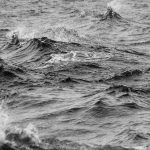A new study entitled Examination of the ocean as a source for atmospheric microplastics suggests the sea breeze might be returning up to 136,000 tonnes of plastic to land every year. This study is an important landmark in tracking the fate of microplastics in the oceans.
What Are Microplastics and Where Can They Be Found?
Despite being so tiny our eyes can’t detect them, microplastics, i.e. small plastic pieces less than five millimeters are a huge concern to Life, biodiversity, and a healthy planet.
Microplastics contaminants have been found everywhere from tap water and drinking-water bottles, human feces and household dust to insects and marine species, in groundwater sources, in wild French rivers, in areas in remote mountains like the Pyrenees, in the oceans’ deepest regions like the Mariana Trench and even in the Arctic ice.
Now, thanks to researchers from the University of Strathclyde and the Observatoire Midi-Pyrénées at the University of Toulouse, whose joint work was recently published in the journal PLOS One, microplastic particles were found in ashore sea breeze too.
New Study Found Microplastics in Ashore Sea Breeze
Using what they called a “cloud catcher”, or, more technically, a Caltech Active Strand Cloudwater Collector, which was set on top of a sand dune, researchers collected sea breeze from Mimizan Beach in Aquitaine, France and analyzed it.
Different water samples from various wind directions and speeds, including a storm and sea fog, were collected in the study. After analyzing them, researchers found microplastics in the sea spray were between 5 micrometers and up to 140 micrometers long. The sea fog caused by the surf produced the highest counts: 19 plastic particles per cubic meter of air.
The data collected and the conclusions it led to shed light on the possibility of ocean to atmosphere transmission. The authors believe it is possible that plastic can be “atmospherically entrained from bubble action/jet expulsion in a similar manner to sea salt aerosols (SSA) and other oceanic particulates.”
Ashore Sea Breeze Helps Microplastics Move Around
It looks like “some plastic particles could be leaving the sea and entering the atmosphere along with sea salt, bacteria, viruses and algae”, the study’s lead co-author, Dr. Deonie Allen, told the Guardian.
The study’s results help partially explain the mystery of where ocean plastic goes. The study provides a relevant answer to the question: “what happens to plastic once it reaches the water surface?
This is a relevant question because it is known that large amounts of plastic waste, around 8 million tonnes, enter the ocean water every year and that only 240,000 tonnes are estimated to float on the water surface.
Ocean plastic transport and sink models are being explored by the scientific community with the goal of finding out where to and how plastic travels. However, like Dr. Allens says, “the transport mechanism is quite complicated (…) we know plastic comes out of rivers into the sea (…) some goes into gyres, some sinks and goes into the sediment, but the quantity on the seafloor doesn’t match the amount of plastic that would make up this equation. There’s a quantity of missing plastic.”
Now the study co-led by Dr. Allen helps provide an answer to the microplastics enigma: some microplastics might be returning to land by sea spray every year. Up to 136,000 tonnes of microplastic, to be more exact.
- Related: It Was Bad And It’s Getting Worse: Melting Permafrost Is Contributing to Climate Change Too
The Need To Manage Plastic Waste and Pollution
A better understanding of what is happening to plastic and microplastic is key to finding a solution to the various problems they cause. However, applying the precautionary principle and tackling the problem at its source its key to prevent problems from arising in the first place.
There is no doubt we have been mismanaging waste coming from the terrestrial environment. It is estimated that 10% of all plastic produced is lost to the sea each year, which means around 4.8–12.7 million tons of plastic entered the oceans from coastal and terrestrial areas, with up to 92% of this being <4.75mm in size, a study suggests.
The WWF says there are 3 main ways in which plastic ends up in the oceans. By finding a solution to each of these problems, together with alternatives to plastic use, we’ll be closer to solving the plastic problem:
- How does plastic end up in the ocean? According to WWF:
- Plastic that is thrown to the bin rather than recycled and ends up taken away in landfills by the wind;
- Litter dropped in the streets that fly until water regions or that is dragged by rainwaters to drains that ultimately end up in the oceans;
- Litter flushed down toilets, from wet wipes, cotton buds, or cosmetic products to microfibers released into waterways when we wash our clothes in the washing machine.
[Photo by Ray Fragapane on Unsplash]

